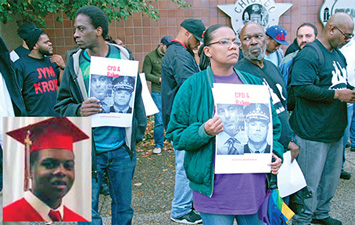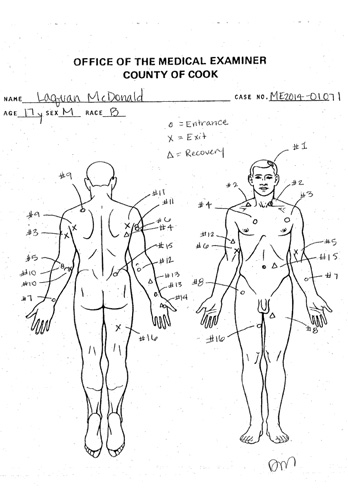Chicago on edge after judge orders suppressed footage of police shooting be made public
By Ashahed M. Muhammad -Assistant Editor- | Last updated: Nov 25, 2015 - 8:57:52 AMWhat's your opinion on this article?
CHICAGO - A Cook County judge ruled video footage of a Black teenager being gunned down by police must be released to the public, and now, the fallout from that decision is being felt.
The Federal Bureau of Investigation and the Cook County State’s Attorney’s office conducted joint investigations related to the October 20, 2014 shooting death of 17-yearold LaQuan McDonald by Ofc. Jason Van Dyke. At Final Call press time, it was expected that Ofc. Van Dyke will be charged with first-degree murder.

Protesters demand release of dashcam footage of shooting of LaQuan McDonald, shown in graduation photo. Photo: Haroon Rajaee
|
Mayor Rahm Emanuel met with community leaders Nov. 23 and told the media in his view, Ofc. Van Dyke failed to carry out his duties properly.
Judge Franklin Valderrama declared video footage of the shooting must be released by Nov. 25, in response to a public records request by a journalist under the Freedom of Information Act, and it appears his ruling acted as a catalyst leading to increased levels of outreach from Mayor Emanuel’s office as well as State’s Attorney Anita Alvarez. Both were heavily criticized for their slow movement to release the video footage.
Community leaders shared the frustrations of the youth, and said they could not promise things would remain peaceful. The Black community is suffering, lacks resources, and there are many hurting and angry people, they said.
Community activist Jedidiah Brown described what the police officer did to Mr. McDonald as a “slaughter.” He said the community has lost faith and trust in many of their leaders, and it is time for everyone to put aside petty things and personal agendas if a transformation is to take place in the areas where police involved shootings and Black on Black shootings have become regular occurrences.

Autopsy of Laquan McDonald's body.
|
Some objected to the city holding back on the video, despite the uprisings in other parts of the United States related to police brutality and the killing of unarmed Blacks. City officials feared once the footage was shown, it could add to existing levels of community outrage regarding police involved shootings of Blacks, possibly leading to massive protests like those seen in New York, Baltimore and Ferguson, Missouri, or worse.
In the closely watched case, Mr. McDonald, reportedly only armed with a small knife and according to some witnesses walking away from police officers, not posing a threat, was shot and killed by Ofc. Van Dyke. What led to the shooting has been disputed, however, initially a police spokesperson said Mr. McDonald advanced towards officers with a weapon. The autopsy showed Mr. McDonald was shot 16 times, including twice in the back.
According to the Citizens Police Data Project, there have been 18 misconduct complaints against Ofc. Van Dyke however none have resulted in disciplinary action.
To complicate matters, according to multiple news reports 86 minutes of video footage from a nearby Burger King was missing, and according to the restaurant’s district manager, it was deleted by members of the Chicago Police Department in the minutes following the shooting.
The surveillance footage missing was between 9:13 and 10:39 p.m., according to lawyers for McDonald’s family. The shooting occurred at approximately 9:50 p.m. The city of Chicago and the Chicago Police Department officials have resisted pressure from community groups calling for the release of additional dashcam video footage that would show events leading up to what occurred on that October night.
Attorneys for the family who have seen the video said the police officer shot teen Mc- Donald multiple times after he was lying in the street.
The city of Chicago has paid out millions in taxpayer dollars settling cases of police misconduct and fighting charges of use of excessive force and restitution for wrongful imprisonment, with some cases taking decades to resolve, however in this case, a speedy $5 million settlement was approved by the Chicago City Council within six months of the incident.
In the past, Mayor Emanuel’s comments regarding the release of the video have been cautious, but in a Nov. 19 statement, it appears he was distancing himself and the city from the actions of the officer.
“Police officers are entrusted to uphold the law, and to provide safety to our residents. In this case, unfortunately, it appears an officer violated that trust at every level,” the mayor’s statement said. “In accordance with the judge’s ruling the City will release the video by November 25, which we hope will provide prosecutors time to expeditiously bring their investigation to a conclusion so Chicago can begin to heal.”
Chicago police and the mayor had maintained the footage should not be released because it was part of the evidence in a case under investigation. Police say the victim was shot because he refused to drop a knife when ordered. However, it is clear that if the roles were reversed, with Mr. McDonald shooting the police officer, there likely would have been no objections to the footage being immediately released.
Clergy, political officials and political candidates, as well as community activists and concerned residents met recently at New Beginnings Church led by Pastor Corey Brooks. There were many contentious moments during the meeting with different opinions and strategies related to handling the aftermath once the video footage is released.
With the death of Mr. McDonald, and attention again being focused on Chicago, Mr. Brown said this is an opportunity for the leaders and the people to “put our differences aside” to ensure that voices that have been silenced and issues that have been ignored will come to the forefront.
“This is not about who is going to be on the camera; this isn’t about who is going to get money—our community is in a terrible state,” said Mr. Brown.
Attorneys for the family said they would prefer the video footage not be released because of the emotional pain it would cause. For others, especially in a city with such a sordid record of police misconduct and corruption, transparency is needed.
The American Civil Liberties Union of Illinois fully supports the public release of the Laquan McDonald video. “Transparency about our police force is a critical component of public oversight and accountability,” the Illinois ACLU said. “Videos such as this one have been released across the nation furthering an important and necessary discussion on policing and police-community relations.”
At a press conference held shortly after the judge’s ruling was announced, Attorney Matt Topic said the city of Chicago had repeatedly asked for extensions after the initial request in May, but now, it is clear those were just delay tactics aimed at preventing release of the video. He was joined by University of Chicago law professor Craig Futterman who has conducted groundbreaking research on Chicago police misconduct, South Side community activist William Calloway and Brandon Smith, the independent journalist who initially asked for the video via a FOIA request.
“Videos speak a lot louder than descriptions of videos,” said Mr. Smith.
Mr. Smith told reporters if there were protests, he would support them because displays of public anger, investigative research, and articles by independent journalists have made a difference in raising awareness regarding police misconduct nationwide.
“The public has a right to be angry about what may have happened there that day. The public has the constitutionally protected right to go to the streets and protest,” said Mr. Smith. “There has been reform because of public outrage and a video can really help,” he added.
Mr. Calloway, who leads the social justice group Christianaire said the last time he was in a courtroom, he watched helplessly as Chicago police detective Dante Servin walked away on a technicality in the shooting death of 22-yearold Rekia Boyd. It was reported Nov. 23 that Mr. Servin would be fired the same day his colleague was charged.
In March of 2012, Mr. Servin fired five shots in the dark at a crowd of people on the West Side. He said he thought a person in the crowd pointed a gun at him when in fact it was determined that no one pointed a gun at him, and no one in the crowd was “armed” with anything other than a cell phone. One of the bullets hit Ms. Boyd in the back of her head killing her.
Strangely, a judge ruled Mr. Servin could not be convicted of first-degree murder because the Illinois State’s Attorney Anita Alvarez charged him with involuntary manslaughter. At the same time, Mr. Servin could not be convicted of involuntary manslaughter because in the judge’s view, the evidence did not support the charge that Mr. Servin displayed reckless behavior. So he was found not guilty, because in the view of many critics, the charges were not strong enough. The city settled a wrongful-death lawsuit with Rekia Boyd’s family for $4.5 million but admitted no liability.
Mr. Calloway said immediate action is needed to prevent another case of reckless behavior by police from going unpunished.
“This is about justice! This is about transparency,” said Mr. Calloway. Police have the authority to use lethal force and most of the time, it is used in cases involving Blacks and Latinos, and the system that backs and protects police officers in these types of cases must be vigorously challenged, he noted.
When asked if he thought there would be protests after the video is released?
“Only time will tell. Nobody knows,” Mr. Calloway answered.
INSIDE STORIES AND REVIEWS
-
-
About Harriett ... and the Negro Hollywood Road Show
By Rabiah Muhammad, Guest Columnist » Full Story -
Skepticism greets Jay-Z, NFL talk of inspiring change
By Bryan 18X Crawford and Richard B. Muhammad The Final Call Newspaper @TheFinalCall » Full Story -
The painful problem of Black girls and suicide
By Charlene Muhammad -National Correspondent- » Full Story -
Exploitation of Innocence - Report: Perceptions, policies hurting Black girls
By Charlene Muhammad -National Correspondent- » Full Story -
Big Ballin: Big ideas fuel a father’s Big Baller Brand and brash business sense
By Bryan Crawford -Contributing Writer- » Full Story






 Click Here Stay Connected!
Click Here Stay Connected!








